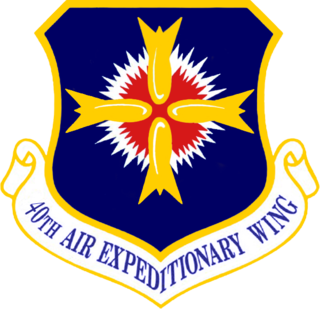
The 19th Air Division is an inactive United States Air Force formation. Its last assignment was with Eighth Air Force at Carswell Air Force Base, Texas, where it was inactivated on 30 September 1988.

The United States Air Force's 40th Air Expeditionary Wing was an Air expeditionary unit located at Diego Garcia, in the Indian Ocean, from 2002 to c. 2006. The 40 AEW's mission was to support combat forces in Afghanistan and other combat areas supporting Operation Enduring Freedom. Operations began in October 2001.

The 58th Air Division is an inactive United States Air Force unit. Its last assignment was with Air Defense Command, based at Wright Patterson Air Force Base, Ohio. It was inactivated on 1 February 1959.

The 10th Missile Squadron is a United States Air Force unit. It is assigned to the 341st Operations Group, stationed at Malmstrom Air Force Base, Montana. The squadron is equipped with the LGM-30G Minuteman III Intercontinental ballistic missile, with a mission of nuclear deterrence.

The 25th Space Range Squadron is a squadron of the United States Space Force. It is assigned to the Space Delta 11 at Schriever Space Force Base, Colorado, US. The 25th operates the Space Test and Training Range along with the 379th Space Range Squadron of the United States Air Force Reserve.

The 66th Missile Squadron is an inactive United States Air Force unit. It was last assigned to the 44th Operations Group, stationed at Ellsworth Air Force Base, South Dakota. The 66th was equipped with the LGM-30F Minuteman II Intercontinental ballistic missile, with a mission of nuclear deterrence. With the end of the Cold War, the 66th was inactivated on 1 September 1993. Number of flights 100

The 970th Airborne Air Control Squadron is part of the 513th Air Control Group at Tinker Air Force Base, Oklahoma. It operates the Boeing E-3 Sentry aircraft conducting airborne command and control missions.

The 99th Reconnaissance Squadron is a squadron of the United States Air Force. It is assigned to the 9th Operations Group, Air Combat Command, stationed at Beale Air Force Base, California. The squadron is equipped with the Lockheed U-2 Dragon Lady reconnaissance aircraft.

The 9th Operations Group is the operational flying component of the 9th Reconnaissance Wing, stationed at Beale Air Force Base, California.

The 2d Bombardment Squadron is an inactive United States Air Force unit. Its last assignment as a Boeing B-52 Stratofortress squadron was with the Strategic Air Command 22d Bombardment Wing stationed at March Air Force Base, California. It was inactivated on 1 October 1982. The unit was redesignated as the 2d Strategic Squadron as a Boeing KC-135 Stratotanker rotational squadron with the 306th Strategic Wing and was last active at RAF Mildenhall, England in 1992.

The 59th Bombardment Squadron is an inactive United States Air Force unit. It was first activated in Panama in 1941 during the expansion of the United States Army Air Corps before World War II. Following the Attack on Pearl Harbor the squadron participated in antisubmarine patrols in the Caribbean Sea and adjoining waters. When the United States Navy assumed this mission in 1943, the squadron moved to the United States and was disbanded.

The 3rd Bombardment Squadron is an inactive United States Air Force unit. Its last assignment was with the 111th Strategic Reconnaissance Wing, based at Travis Air Force Base, California. It was inactivated on 1 January 1953.

The 74th Reconnaissance Squadron is an active United States Air Force unit, part of the 9th Reconnaissance Wing at Beale Air Force Base, California. The squadron was first active during World War II as the 74th Aero Squadron. In 1933 it was consolidated with the 74th Pursuit Squadron, which had been organized as a reserve training organization in 1927, activating in the Panama Canal Zone, where it served during World War II as the 74th Bombardment Squadron.

The 44th Reconnaissance Squadron is a unit of the United States Air Force's 432nd Wing, Air Combat Command stationed at Creech Air Force Base, Nevada, where it operates unmanned aerial vehicles. The squadron is assigned to the 432nd Operations Group, and has been reported to operate the Lockheed Martin RQ-170 Sentinel.

The 45th Bombardment Squadron is an inactive United States Air Force unit. Its last assignment was with the 40th Bombardment Wing, based at Forbes Air Force Base, Kansas. It was inactivated on 1 September 1964.

The 67th Missile Squadron is an inactive United States Air Force unit. It was last assigned to the 44th Operations Group, stationed at Ellsworth Air Force Base, South Dakota.

The 68th Missile Squadron is an inactive United States Air Force unit. It was last assigned to the 44th Operations Group, stationed at Ellsworth AFB, South Dakota.

The 6th Operations Group is the operational flying component of the 6th Air Refueling Wing, stationed at MacDill Air Force Base, Florida.

The 395th Tactical Missile Squadron is a United States Air Force unit. It has not been active under that name.

This is a list of United States Army Air Forces Consolidated B-24 Liberator units and formations during World War II including variants and other historical information. Heavy bomber training organizations primarily under II Bomber Command in the United States and non-combat units are not included.





















